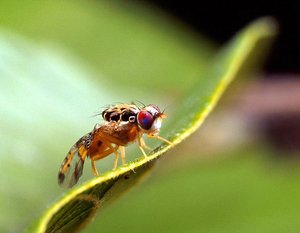Fly
|
|
- This article is about the insect. For other meanings, see Fly (disambiguation)

A fly (plural flies) is any species of insect of the order Diptera, some of which can land on food and transmit bacteria to humans. Flies are common amongst humans and have caused many diseases to spread in the past. The house-fly (Musca domestica) is particularly common amongst humans. Other flies, such as the horse-fly (Family Tabanidae), can inflict painful bites. The larva of a fly is commonly called a maggot.
| Contents |
Maggots
White_maggot.JPG
Some types of maggots found on corpses can be of great use to forensic scientists. By their stage of development, these maggots can be used to give an indication of the time elapsed since death, as well as the place the organism died. The size of the house fly maggot is 9.5-19.1mm (3/8 to 3/4 inch). At the height of the summer season, a generation of flies (egg to adult) may be produced in 12-14 days.
Maggot identification uses a classification called "Instar" stages. An instar I is about 2-5 mm long; instar II 6-14 mm; instar III 15-20 mm. Respectively, these measure about 2-3 days, 3-4 days, and 4-6 days (for average houseflies or bottleflies) since the eggs were laid. By use of this data, plus other signs, the approximate time since death can be estimated by forensic scientists.
Some maggots are leaf miners.
Maggots are bred commercially, as a popular bait in angling, and a food for carnivourous pets such as reptiles or birds.
Use in medicine
Some maggots which eat dead, but not living, flesh have been used medically, being introduced into wounds to clean them. Other maggots, such as the screwworm, eat live flesh.
In the early days of medicine, maggot infestations of wounds (myiasis) were inevitable. The wounds that were infested tended to be less life-threatening than wounds without the infestation, so until the development of antibiotics it was common practice to leave the maggots. After antibiotics, the presence of maggots became viewed as unhygienic. In recent years, however, use of specially sanitized maggots has developed as a treatment for various types of wounds such as leg ulcers and pressure sores, gangrene and other bacterial infestations, since the maggot will only eat the dead, rotting and infected flesh and leave the living cells intact. It is especially useful for people with weakened immune systems or blood flow that become infected in the extremities, such as diabetics, and is particularly effective in treating diabetic foot problems.
Fly-like insects
Empis_tesselata_male_(aka).jpg
A_Fly_by_Matthias_Zimmermann.jpg
The word "fly" also refers to insects of various orders other than Diptera. Entomologists try to distinguish between true flies and other orders by hyphenating the names of true flies (house-fly, horse-fly, crane-fly), but giving the members of other orders unhyphenated names, either with two unconnected words (caddis fly, alder fly) or with a single, concatenated name (dragonfly, stonefly).
- firefly - Coleoptera:Lampyridae
- caddis fly - Trichoptera
- dragonfly and damselfly, Odonata
- butterfly - Lepidoptera
- stonefly - Plecoptera
- mayfly - Ephemeroptera
- sawfly - Hymenoptera:Tenthredinidae
- scorpionfly and Hangingfly - Mecoptera
- alder fly, Dobson fly, and Fish fly - Megaloptera
Animal Pictures and Photographs
- Clipart (http://classroomclipart.com/clipart/Clipart.htm)
- Animal Clipart (http://classroomclipart.com/clipart/Clipart/Animals.htm)
- Animal Animated Clipart (http://classroomclipart.com/clipart/Animations/Animals.htm)
- Pictures of Animals (http://classroomclipart.com/clipart/Animals.htm)
- Amphibian Clip Art, Pictures and Photographs (http://classroomclipart.com/clipart/Animals/Amphibians.htm)
- Farm Animal Clip Art, Pictures and Photographs (http://classroomclipart.com/clipart/Animals/Farm_Animals.htm)
- Mammal Clip Art, Pictures and Photographs (http://classroomclipart.com/clipart/Animals/Mammals.htm)
- Marine Animal Clip Art, Pictures and Photographs (http://classroomclipart.com/clipart/Animals/Marine_Life.htm)
- Reptile Clip Art, Pictures and Photographs (http://classroomclipart.com/clipart/Animals/Reptiles.htm)
- Spider Clip Art, Pictures and Photographs (http://classroomclipart.com/clipart/Animals/Spiders.htm)
- Assortment of Videos (http://classroomclipart.com/clipart/Videos.htm)
- Animal Videos (http://classroomclipart.com/clipart/Videos/Animals.htm)
External link
- Pictures of Flies and Other Observations (http://fohn.net/pictures-of-flies/)
- Information and Pictures About Flying Insects (http://www.arkayltd.co.uk/pages/info_education.html)
- Picture: Fly on a window (http://wetterchronik.de/mm/tiere/fliege7.htm)
- Introduction to maggot therapy (http://www.larve.com/maggot_manual/)
- FAQ on maggot therapy (http://www.larve.com/faq/)
